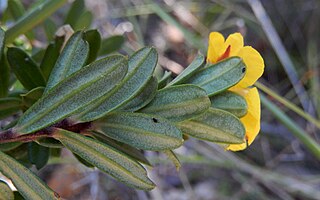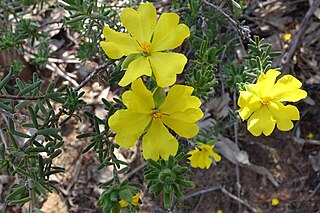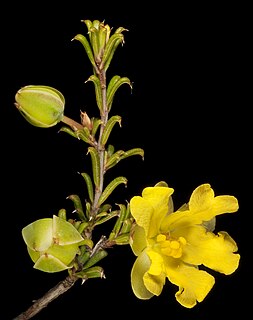
Hibbertia sericea, commonly known as silky guinea-flower, is a species of flowering plant in the family Dilleniaceae and is endemic to south-eastern Australia. It is an erect or spreading shrub with softly-hairy branches, elliptic to egg-shaped leaves with the narrower end towards the base, and yellow flowers with eight to fourteen stamens in a cluster on one side of two hairy carpels.

Hibbertia hypericoides, commonly known as yellow buttercups, is a species of flowering plant in the family Dilleniaceae and is endemic to the south-west of Western Australia. It is usually a spreading shrub with linear to elliptic or egg-shaped leaves, and yellow flowers, usually with ten to fifteen stamens arranged in a cluster on one side of the two densely hairy carpels.

Hibbertia riparia, commonly known as erect guinea-flower, is a species of flowering plant in the family Dilleniaceae and is endemic to the south-eastern Australia. It is an erect to spreading shrub with hairy foliage, linear leaves and yellow flowers with six to sixteen stamens in a single cluster on one side of two carpels.

Melaleuca ciliosa is a small shrub in the myrtle family, Myrtaceae and is endemic to the south-west of Western Australia. It has bright or pale yellow flowers, an unusual calyx and leaves that are slightly hairy, especially around the edges.
Hibbertia charlesii is a species of flowering plant in the family Dilleniaceae and is endemic to a restricted part of the south-west of Western Australia. It is a spreading shrub with crowded, upward-pointing linear leaves and golden yellow flowers with five stamens fused at their bases and up to twenty staminodes, all on one side of two densely hairy carpels.
Hibbertia crassifolia is a shrub in the Dilleniaceae family and is endemic to Western Australia. It is an erect shrub with multiple stems that typically grows to a height of 0.2 to 0.6 m but can reach 0.9 m. It blooms between April and September and produces yellow flowers. The species has a scattered distribution through the western Wheatbelt region of Western Australia between Three Springs in the north, Ballidu in the east and Wandering in the south where it is found on sandplains and breakaways growing in sandy lateritic soils.

Boronia oxyantha is a plant in the citrus family, Rutaceae and is endemic to a small area in the south-west of Western Australia. It is a shrub with many hairy branches, pinnate leaves and pink, four-petalled flowers that have a darker midrib.

Hibbertia bracteata is a species of flowering plant, in the family Dilleniaceae, and is endemic to eastern New South Wales. It is a shrub with lance-shaped to oblong leaves and yellow flowers with about sixteen stamens arranged on one side of the two carpels.

Hibbertia acicularis, commonly known as prickly guinea-flower, is a species of flowering plant in the family Dilleniaceae and is endemic to eastern Australia. It is an erect or prostrate shrub with linear to lance-shaped leaves and yellow flowers arranged singly in leaf axils with the six to eight stamens joined at the base, in a single cluster.
Hibbertia cinerea is a species of flowering plant in the family Dilleniaceae and is endemic to the southern part of the Eyre Peninsula in South Australia. It is a densely-branched, hairy shrub with narrow elliptic to lance-shaped leaves, and yellow flowers arranged on the ends of branchlet, with nine to twelve stamens arranged in a group on one side of the two carpels.

Hibbertia covenyana is a species of flowering plant in the family Dilleniaceae and is endemic to New South Wales. It is an erect or semi-prostrate shrub with hairy foliage, oblong leaves and yellow flowers with seven to ten stamens arranged on one side of the two carpels.
Hibbertia depilipes is a species of flowering plant in the family Dilleniaceae and is endemic to the far south-west of Western Australia. It is usually a sprawling shrub with scattered linear leaves and yellow flowers arranged singly in leaf axils usually with ten stamens all on one side of the two carpels.
Hibbertia drummondii is a shrub in the family Dilleniaceae family and is endemic to Western Australia. It is an erect shrub that typically grows to a height of 0.3–1 m. It flowers from September to October and produces yellow flowers. The species was first described in 1849 by Nikolai Turczaninow in the Bulletin de la Société Impériale des Naturalistes de Moscou and given the name Ochrolasia drummondii. In 1893, Ernest Friedrich Gilg changed the name to Hibbertia drummondii in Die Natürlichen Pflanzenfamilien. The specific epithet (drummondii) honours James Drummond.
Hibbertia furfuracea is a species of flowering plant in the family Dilleniaceae and is endemic to near-coastal areas of south-western Western Australia. It is an erect shrub with narrow egg-shaped leaves with the narrower end towards the base, and yellow flowers borne in upper leaf axils, with ten to twelve stamens all on one side of two carpels.
Hibbertia hamulosa is a species of flowering plant in the family Dilleniaceae and is endemic to the south coast of Western Australia. It is a shrub with somewhat crowded, thick, linear leaves and golden yellow flowers with five to eight stamens fused at their bases, all on one side of two densely hairy carpels.
Hibbertia helianthemoides is a species of flowering plant in the family Dilleniaceae and is endemic to a small area in the south-west of Western Australia. It is a prostrate to low-lying, spreading to erect, hairy shrub with hairy foliage, linear leaves and yellow flowers with thirteen stamens.

Hibbertia mucronata is a species of flowering plant in the family Dilleniaceae and is endemic to the south of Western Australia. It is an erect shrub with hairy branches, crowded, thick, tapering linear leaves ending in a sharp point, and golden yellow flowers with five stamens fused at their bases, all on one side of two densely hairy carpels.
Hibbertia pachyphylla is a species of flowering plant in the family Dilleniaceae and is endemic to Western Australia. It is a shrub with thick, oblong leaves and yellow flowers with five stamens in a bundle on one side of two hairy carpels.
Pultenaea spinulosa is a species of flowering plant in the family Fabaceae and is endemic to the south of Western Australia. It is a shrub with flat, hairy leaves, and uniformly yellow flowers.

Hibbertia rostellata is a species of flowering plant in the family Dilleniaceae and is endemic to the south-west of Western Australia. It is a low, straggling or erect shrub that typically grows to a height of 15–50 cm (5.9–19.7 in) and flowers between August and November producing yellow flowers. It was first formally described in 1849 by Nikolai Turczaninow in the Bulletin de la Société Impériale des Naturalistes de Moscou. The specific epithet (rostellata) means "possessing a small beak or snout", referring to the tip of leaves.









